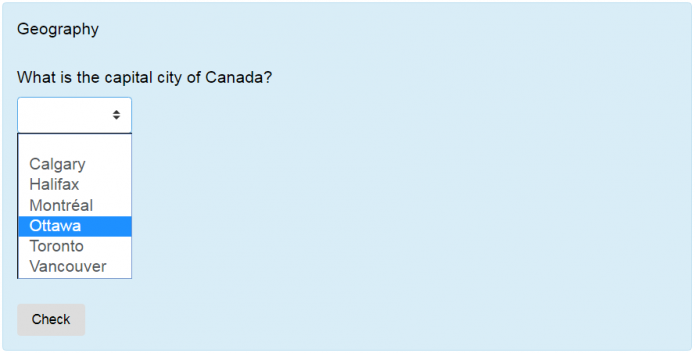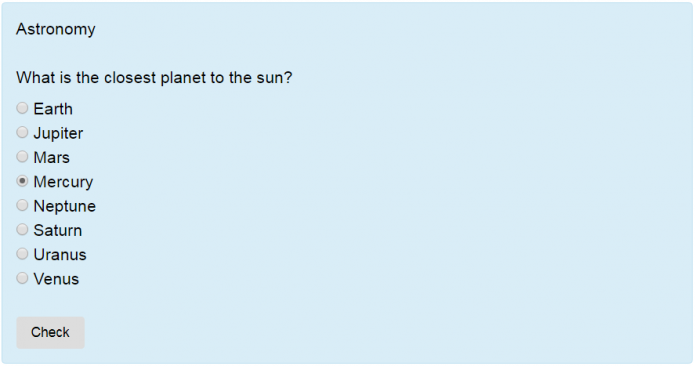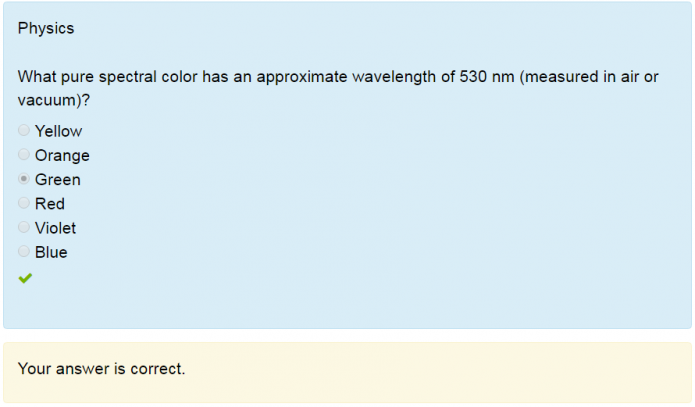FQT Multiple choice placeholders: Difference between revisions
No edit summary |
|||
| (12 intermediate revisions by the same user not shown) | |||
| Line 1: | Line 1: | ||
{{Formulas question type}} | {{Formulas question type}} | ||
In addition to the answer box placeholders, the '''Formulas | ==Why make a FQT multiple choice question?== | ||
In addition to the answer box placeholders, the '''Formulas''' question type provides for two other types of placeholder which are used for multiple choice questions: | |||
* Dropdown menu placeholder | * Dropdown menu placeholder | ||
* Radio buttons placeholder | * Radio buttons placeholder | ||
FQT multiple choice questions allows you to use all the power of the '''Formulas''' calculation engine to build the list of choices. | |||
==Dropdown menu placeholder== | ==Dropdown menu placeholder== | ||
| Line 42: | Line 42: | ||
[[File:CapitalCanada.png|695px]] | [[File:CapitalCanada.png|695px]] | ||
<div style="margin:20px 0 20px;"> | |||
[http://35.193.77.29/mod/quiz/view.php?id=116 <span style="background-color:#f98012;box-shadow: 0 5px 10px #cbcbcb;border: none;color:white;padding: 8px 16px;text-align:center;text-decoration: none;cursor:pointer;">Play it</span>] | [http://35.193.77.29/mod/quiz/view.php?id=116 <span style="background-color:#f98012;box-shadow: 0 5px 10px #cbcbcb;border: none;color:white;padding: 8px 16px;text-align:center;text-decoration: none;cursor:pointer;">Play it</span>] | ||
</div> | |||
</div> | </div> | ||
| Line 60: | Line 57: | ||
Use a radio buttons placeholder to make a multiple choice question. | Use a radio buttons placeholder to make a multiple choice question. | ||
<pre style="font-size:113%;width: 98%;"> | <pre style="font-size:113%;width: 98%;"> | ||
| Line 84: | Line 79: | ||
[[File:PlanetClosestSun.png|695px]] | [[File:PlanetClosestSun.png|695px]] | ||
<div style="margin:20px 0 20px;"> | |||
[http://35.193.77.29/mod/quiz/view.php?id=118 <span style="background-color:#f98012;box-shadow: 0 5px 10px #cbcbcb;border: none;color:white;padding: 8px 16px;text-align:center;text-decoration: none;cursor:pointer;">Play it</span>] | |||
</div> | |||
</div> | </div> | ||
| Line 129: | Line 129: | ||
[[File:ShuffledMultipleChoice.png|695px]] | [[File:ShuffledMultipleChoice.png|695px]] | ||
<div style="margin:20px 0 20px;"> | |||
[http://35.193.77.29/mod/quiz/view.php?id=122 <span style="background-color:#f98012;box-shadow: 0 5px 10px #cbcbcb;border: none;color:white;padding: 8px 16px;text-align:center;text-decoration: none;cursor:pointer;">Play it</span>] | |||
</div> | |||
</div> | </div> | ||
Revision as of 17:00, 9 December 2017
Why make a FQT multiple choice question?
In addition to the answer box placeholders, the Formulas question type provides for two other types of placeholder which are used for multiple choice questions:
- Dropdown menu placeholder
- Radio buttons placeholder
FQT multiple choice questions allows you to use all the power of the Formulas calculation engine to build the list of choices.
The syntax for this placeholder is {_n:choices:MCE} where _n is the placeholder name (_0, _1, _2, etc.) as for the answer box placeholders, choices is a list of strings to appear as the menu choices and MCE must appear as is.
Use a dropdown menu placeholder to make a multiple choice question.
General
Question name* A formulas question with a dropdown menu multiple choice question
Variables
Global variables cities=["Calgary","Halifax","Montréal","Ottawa","Toronto","Vancouver"];
Main question
Question text* Geography
{#1}
Part 1
Part's mark* 1
Answer type Number
Answer* 3
Grading criteria* Absolute error == 0
Placeholder name #1
Part's text What is the capital city of Canada?
{_0:cities:MCE}
The formulas question should look like this (the choices are highlighted by moving up and down in the menu):
Radio buttons placeholder
The syntax for this placeholder is {_n:choices} where _n is the placeholder name (_0, _1, _2, etc.) as for the answer box placeholders and choices is a list of strings to appear as the menu choices. The list of buttons is only vertical.
Use a radio buttons placeholder to make a multiple choice question.
General
Question name* A formulas question with a radio buttons multiple choice question
Variables
Global variables planets=["Earth","Jupiter","Mars","Mercury","Neptune","Saturn","Uranus","Venus"];
Main question
Question text* Astronomy
{#1}
Part 1
Part's mark* 1
Answer type Number
Answer* 3
Grading criteria* Absolute error == 0
Placeholder name #1
Part's text What is the closest planet to the sun?
{_0:planets}
The formulas question should look like this (the student must click a choice from the list):
Shuffled choices
With Formulas multiple choice questions, the shuffling of choices is not a built-in option but it can be easily programmed.
Make a Formulas multiple choice question with shuffled choices.
Downloadable question file: ShuffledMultipleChoice.xml. Programming comments are given in this file.
General
Question name* ShuffledMultipleChoice
Variables
Random variables c=shuffle([0,1,2,3,4,5]);
Global variables mc=[" Red"," Orange"," Yellow"," Green"," Blue"," Violet"];
a=3; # The third answer (counting from 0), i.e. Green, is the correct answer.
c=c;
t=c;
for (i:[0:6]) {
t[i]=a==c[i]?i:0;
}
tt=0;
for (i:[0:6]) {
tt=tt+t[i];
}
colors=[mc[c[0]],mc[c[1]],mc[c[2]],mc[c[3]],mc[c[4]],mc[c[5]]];
Main question
Question text* Physics
{#1}
Part 1
Part's mark* 1
Answer type Number
Answer* tt
Grading criteria* Absolute error == 0
Placeholder name #1
Part's text What pure spectral color has an approximate wavelength of 530 nm (measured in air or vacuum)?
{_0:colors}
The formulas question should look as shown below. The choices are shuffled hence in a different order for each student (there are 6! = 720 permutations):
When shuffled choices are required, it is probably easier to use Moodle's core Multiple choice question. The point here is that with the Formulas question, multiple choice questions can be programmed.


